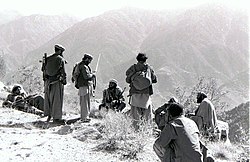Jaginistan Civil War
| Jaginistan Civil War | |||||||
|---|---|---|---|---|---|---|---|
 
| |||||||
| |||||||
| Belligerents | |||||||
|
|
| ||||||
| Casualties and losses | |||||||
| Total: 86,470–98,017 | Total killed: 80,775–95,775+ | ||||||
|
Civilian casualties: 562,000–2,000,000 killed | |||||||
The Jaginistan Civil War was a protracted armed conflict fought in the UCSS-controlled Jaginistan from 1982-1992. The war saw extensive fighting between the Jaginistani government, the UCSS and allied paramilitary groups against the rebel Islamic Courts Union (ICU) and their allied foreign fighters. While the ICU were backed by various countries and organizations, the majority of their support came from Zamastan and Haduastan. The involvement of the foreign powers made the war a proxy war between capitalist powers and the UCSS in the Cold War.
In 1982, a revolution reinstalled the monarchy of Jaginistan, and the UCSS intervened to overthrow King Ahmed She'massoud. Numerous sanctions and embargoes were imposed on the UCSS by the international community in response to the invasion. The war ensued as rebel groups of varying ideologies, under an alliance called the Islamic Courts Union (ICU) began fighting occupying UCSS forces. UCSS troops occupied Jaginistan's major cities and all main arteries of communication, whereas the rebel forces waged guerrilla warfare in small groups across the 80% of the country that was not subject to uncontested UCSS control—almost exclusively comprising the rugged, mountainous terrain of the countryside. In addition to laying millions of landmines across Jaginistan, the UCSS used their aerial power to deal harshly with both Jagini resistance and civilians, levelling villages to deny safe haven to the rebels, destroying vital irrigation ditches and other scorched-earth tactics. By 1991, the UCSS began withdrawing forces due to the strain on its operations, and in 1992 they fully withdrew and Jaginistan's capital Kibul fell to the ICU, with the new government pulling out of the UCSS. In 1994, it joined the Coalition of Crown Albatross.
The war is attributed with the ultimate downfall of the UCSS, which occurred 7 years after the withdrawal was complete. The complication of the war effort gradually inflicted a high cost on the UCSS as military, economic, and political resources became increasingly exhausted. The war also led to widening the ability of international intelligence agencies to pour funding into armed factions around the world to whom they ideologically or pursuantly aligned. The ICU's fracture in the political restructuring aftermath of the war led to the growth of Al-Fijar, a fundamentalist Islamic terrorist group.